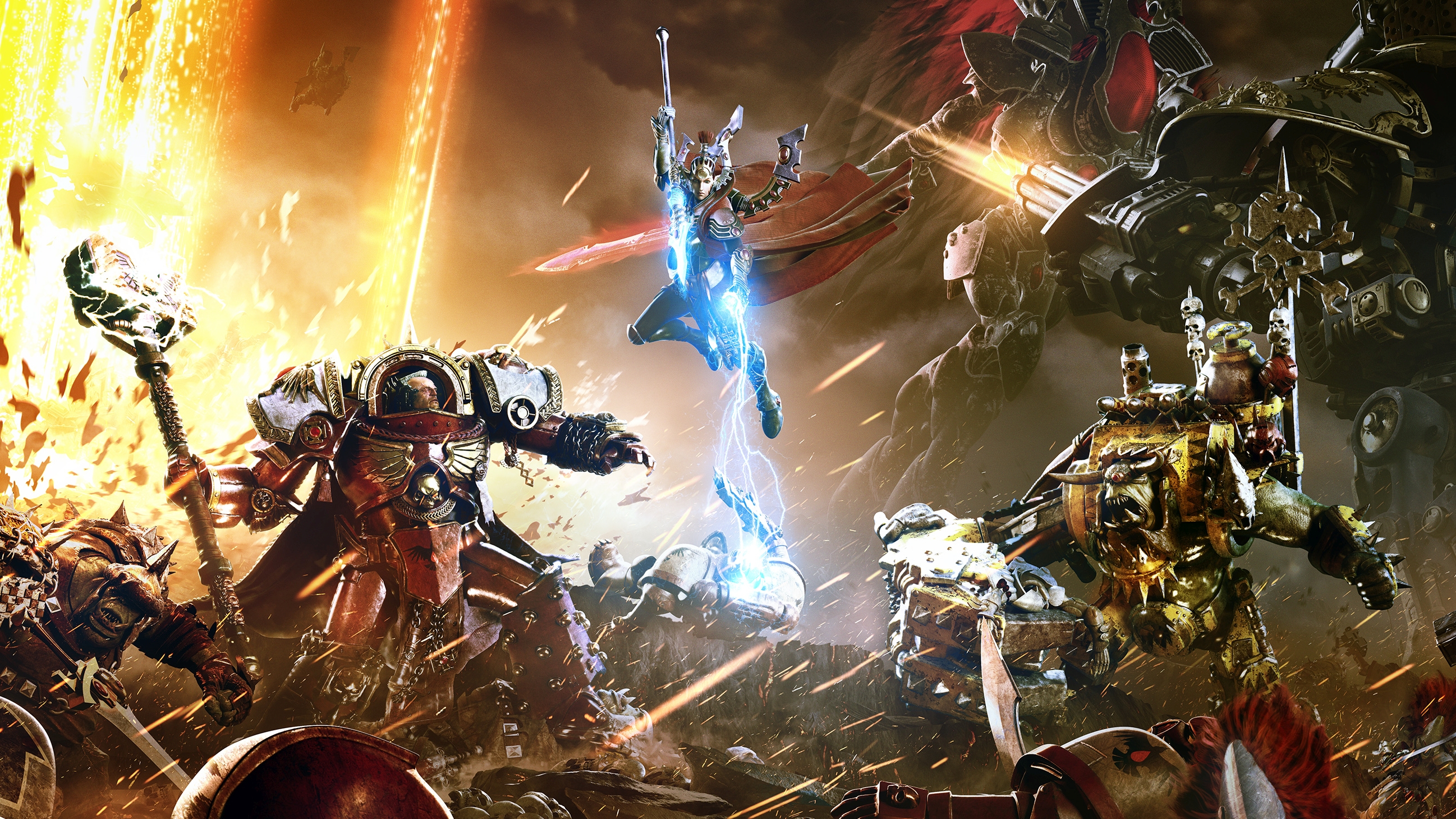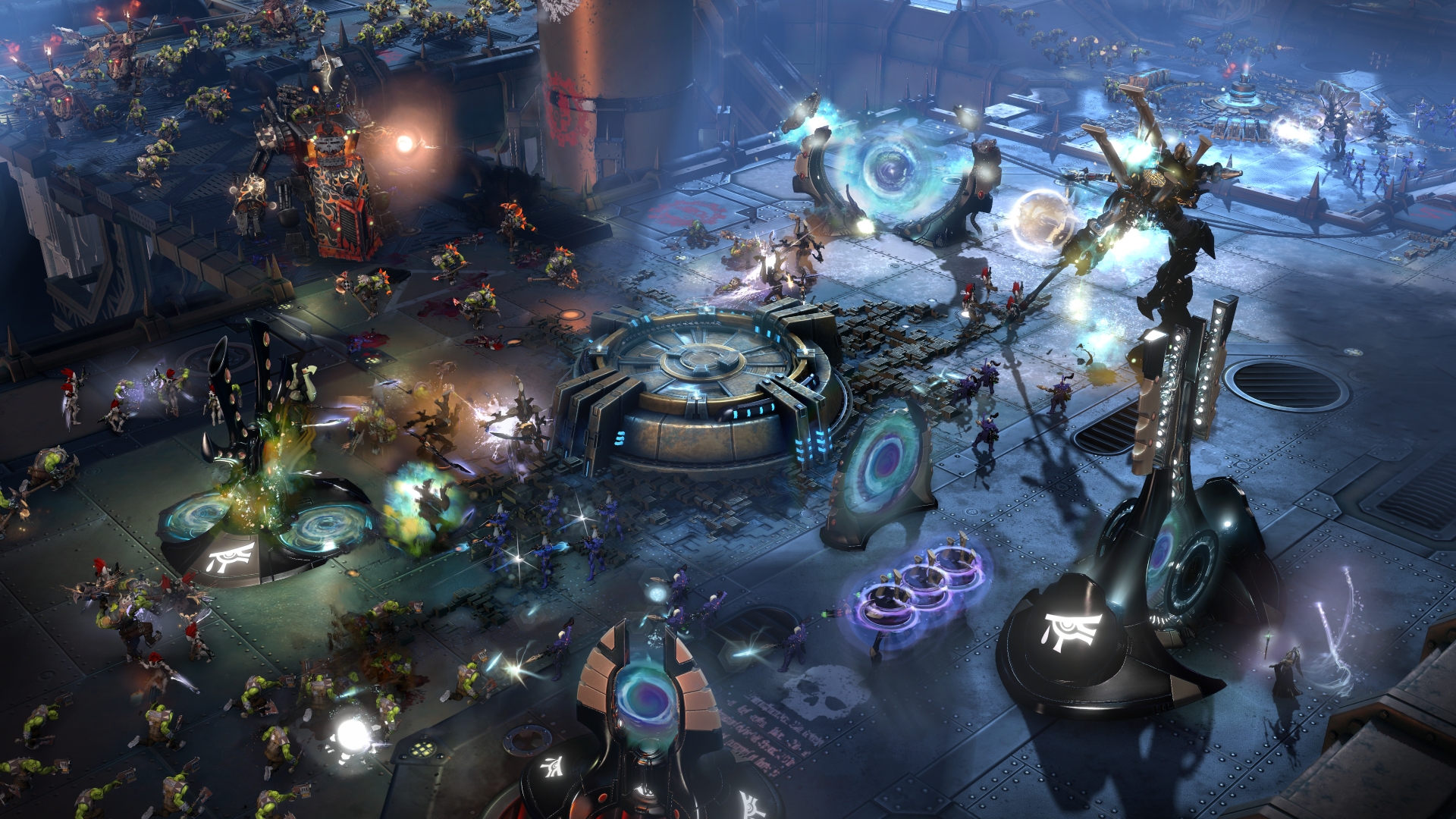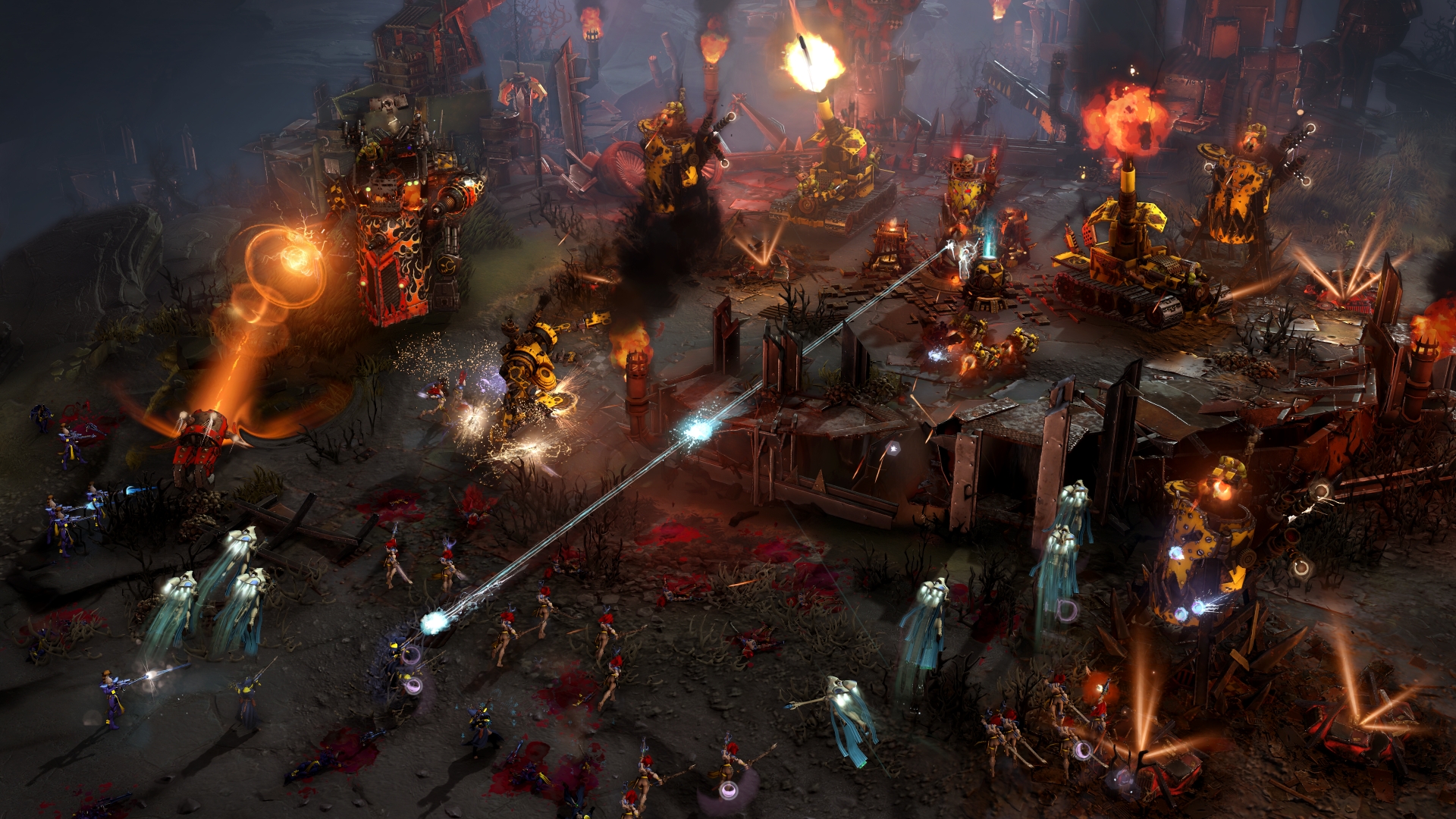Dawn of War 3 multiplayer hands-on: tough, complicated, spectacular
Online is where Dawn of War 3 gets serious.

Life is hard on the battlefields of the 41st millennium, and complicated. In the middle of a 1v1 matchup in Dawn of War 3 I found myself managing half a dozen line units, a trio of micro-heavy heroes, drop pods and a production queue to fend off relentless Eldar assault. Here is a breakdown from halfway through the game. It covers about 30 seconds of play.
The opposing forces clashed in the centre of the map. My huge imperial knight walker used rocket fire and machine gun rounds to fend off squads of dire avengers infantry while the bus-wide master of the Blood Ravens, Gabriel Angelos, chased down flying shadow spectres—the only unit on the field that can really threaten the walker.
As the dire avengers fell, howling banshees swept in in a collective wave, threatening to discover and butcher the heavy-weapons devastator squads I had hidden in stealth zones. I fired down drop pods to scatter them, and then watched the dreadnoughts within pop out and start happily dismembering the enemy. I clicked on each of them and pressed 'Q' to activate their area-of-effect stomps to keep the banshees off their feet. Then I realised that Gabriel Angelos had overreached in his efforts to swat the shadow spectres and was miles away from the action. Also the imperial knight overheated and was trying to sluggishly evade the deadly sustained beam attacks of the spectres, who had successfully relocated beyond a gap in the map that Angelos was trying to hike around.
Also in this moment, I remembered that I had built a forward factory. The original plan was to cycle infantry back and forth from the front line to keep them healthy and reinforced. In reality I'd managed to leave two devastator squads standing around there, nowhere near the fight. My librarian was also there, staring into space. As a hero of the imperium and one of my three elites, he should have definitely been fighting, but there was more to think about. I needed to fill drop pods with more dreadnoughts. I needed to upgrade my resource points to get them to produce a sensible balance of requisition and power, which I could then use to produce more devastators at my forward base. I needed to think about deploying my space laser at a key moment to gut the Eldar force and make a push on the enemy shield generator, which would let me attack the enemy turret, which guarded the enemy core I needed to blow up to win.
There is a lot going on in Dawn of War 3 multiplayer. Probably too much, but enough to satisfy those who worry that this is a shallow game about pretty lasers and elaborate death animations. Three wildly different factions contest dozens of objectives and sub-objectives such as resource points, heavy cover zones, stealth spots and the vital structures you need to destroy to actually win. You can specialise your army with a loadout of doctrines, field any combination of three elites, and paint them all pink with the army customiser. It's hectic, stressful fun. Let's break it down.

Power Core is the only multiplayer mode for now, and it is quite hard
Game director Philippe Boulle explains that Dawn of War's Power Core multiplayer mode is the mode for Dawn of War 3 at launch. "Additional modes is something we'll explore post-launch. I think we wanted to come out with one really good multiplayer experience, and then expand from there."
"We wanted to do this mode because it struck the right balance for us of having intermediary goals across the gameplay experience, rewarding an aggressive playstyle rather than a defensive play style, and concentrating the endgame around some specific points."
Keep up to date with the most important stories and the best deals, as picked by the PC Gamer team.
Each team has a power core, protected by a turret, which in turn is protected by a shield generator. The format loosely resembles the turreted lanes of a MOBA, though attacking this tiered challenge in an RTS, where power is decentralised across an army, feels substantially different. These main objectives are designed to instigate massive fights at key moments, and to divide the battle into distinct phases during which the power levels of the three wildly different factions fluctuate. The Eldar are great in the early game, but struggle to hold their own against the late-game war machines of the Space Marines. These phases are formalised by an escalation mechanic that increases the armour and killing power of listening post turrets, which you build on resource points to fend off attackers.
The single player missions I've played so far have been big entertaining stomps, but multiplayer is deep and difficult, and much more reminiscent of Company of Heroes than I expected. Territory across the map is constantly being contested, and your priorities depend on your faction and build choices. An army designed to become powerful in the late game absolutely must keep the special resource nodes that generate hero points, for example. Dedicated front line buildings such as Ork and Eldar's Waaagh! towers and warp gates give you even more to worry about.
Turrets are dicks
The huge defensive turrets that guard your core are essentially miniature boss fights. They alternate their focus between your units, and roast them with a sustained beam attack. Normally the turret will be reinforced by the opponent's army, of course, so you need to make a huge push to make it through to the core.
Boulle suggests that turret behaviour can be manipulated by savvy players, who might use large mobs of chaff troops to split turret fire between many targets. A failed push on the turret leaves you wide open to counter-attack, so the stakes are high. Turrets essentially create extra drama in the mid-game.

Loadouts define what your army is good at
Before you start a match you fill your three elite slots with heroes and special squads, and then choose three army-wide upgrades. Relic has experimented a lot with this sort of thing in the Company of Heroes series, but formerly slotted upgrades have given a unit an extra 2% damage here or there. In Dawn of War 3 the upgrades are much more significant. One lets Space Marine units replace lost squad members at listening posts. For a slow army like the Marines, the ability to replace losses near the front line is enormously useful. Other upgrades might improve your dreadnoughts, or give particular Ork units the ability to loot grenades from scrap (more on salvaging later).
Elite units such as Space Marine champ Gabriel Angelos also come with battle-wide passive buffs that you can switch between games. Naturally, these can overlap with the army-wide buffs to specialise your force. A Space Marine army that reinforces at listening posts and can heal in an area-of-effect with drop pods plays differently to an army with improved tanks and walkers.
Relic hopes that players will switch between a repertoire of builds depending on the type of game they're in. Boulle gives an idea of the sort of conversation that will hopefully be happening in multiplayer lobbies once the game is out. "I'm going to go early units, you go late units. I'm going to go aggressive infantry, you go aggressive vehicle. We like that sort of team-building exercise. That's where a lot of the beauty of that loadout system will work."
Orks have hidden depths
The Orks are the most unusual faction in the game. They are a brutish horde army that can scavenge junk from the battlefield. Scavenged material—skimmer wrecks, broken dreadnoughts and so on—is sent to nearby Waaagh! towers. These towers determine the tech level available to Orks (five towers unlocks everything) but they also have a few other uses.
When there is enough scrap at the base of a Waaagh! tower, you can order gretchin to build a unit. It could be a killa kan, or even a ramshackle tank if you have enough scrap collected, but it hits the field at about 75% health. You can choose to order your gretchin to repair it up to full health, or you can send it right into combat. The system lets Orks quickly hack together an army from nothing. If you're fighting them, you have to be careful about feeding them loads of junk because it will come right back at you in the form of a demented war robot. This is a very Ork thing to happen.
Waaagh! towers have an ability you can activate to inspire nearby Orks. This improves their hitting power for a short time. The idea is that you mass loads of Orks together under a tower, set off a Waaagh! and then make a push.
The scavenge and buff utility of these towers encourages you to build them near the front line. If you're playing against Orks, it's a good idea to smash their towers whenever possible. You can feasibly squash an Ork force by denying them the full five towers they need to tech up.

You'll have to master elites if you want to win
Elites aren't as complicated and multi-skilled as the heroes of Dawn of War 2, but they do require careful micromanagement to reach their full potential. Late elites inject some apocalyptic spectacle into the finale of a battle, but early elites can be just as important. The stealthy Space Marine deathwatch can come out very early, and they are potent harassers who give you lots of deployment flexibility.
Early, mid and late-game elites need to be watched constantly. You need to manually activate their most powerful abilities, and if you lose them the cooldown can take them out of the fight for minutes—minutes without your imperial knight feels like ages in the closing stages of a battle. To compete effectively online players will need to understand every elite's capabilities. Each faction had five elites to pick from in the multiplayer demo I played, but there are more to come. Hopefully Dawn of War 3's multi-faction singleplayer campaign will put a that knowledge in place.
These spectacular units are my favourite aspect of Dawn of War 3 right now. It's a complex strategy game with lots to master, but when the game's colossal walkers lead two huge armies into a clash for an important point I get the same kick I got from such encounters in Dawn of War 1. The big, expressive animations and stylised particle effects are a little divisive, but I love the bombastic carnage of a big fight. The game looks and sounds incredible. Game director Philippe Boulle reckons that the game will shine in 3v3 matchups, where teams can field all three factions in one frenzied alliance. Having experienced the fury of a massive battle in 2v2, that is going to be insane.
Part of the UK team, Tom was with PC Gamer at the very beginning of the website's launch—first as a news writer, and then as online editor until his departure in 2020. His specialties are strategy games, action RPGs, hack ‘n slash games, digital card games… basically anything that he can fit on a hard drive. His final boss form is Deckard Cain.


